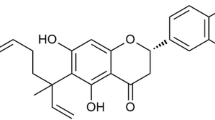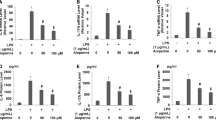Abstract
Hypophyllanthin (HYP) and niranthin (NIR) are major lignans in Phyllanthus spp. and have been shown to possess strong anti-inflammatory activity. In this study, we investigated the anti-inflammatory effects and the underlying molecular mechanisms of HYP and NIR in in vitro cellular model of LPS-induced U937 macrophages. The effects of HYP and NIR on the production of prostaglandin E2 (PGE2), cyclooxygenase-2 (COX-2), tumor necrosis factor-α (TNF-α), and interleukin-1β (IL-1β) were measured by using ELISA, Western blot, and qRT-PCR. The expressions of signaling molecules related to nuclear factor-kappa B (NF-κB), mitogen-activated protein kinases (MAPKs), and phosphatidylinositol 3′-kinase-Akt (PI3K-Akt) signaling pathways were examined. The role of NF-κB, MAPKs, and Akt signaling pathways was confirmed by using specific inhibitors (BAY 11-7082, U0126, SB202190, SP600125, and LY294002) mediated suppression of TNF-α and COX-2 production. HYP and NIR significantly inhibited the protein and gene levels of COX-2 as well as the downstream signaling products of PGE2, TNF-α, and IL-1β. HYP and NIR also suppressed the inhibitors of kappa B (IκB), IkB kinases (Ikkα/β), NF-κB phosphorylation, and IκB degradation. HYP suppressed the phosphorylation of c-Jun N-terminal kinase (JNK), extracellular signal-regulated kinase (ERK), and p38 while NIR only suppressed JNK and ERK but did not have effect on p38. These results demonstrate that HYP and NIR downregulated COX-2, TNF-α, and IL-1β gene expressions in U937 macrophages by interfering with the activation of NF-κB, MAPKs, and Akt. In conclusion, these lignans have potential to be developed as anti-inflammatory agents targeting the NF-κB, MAPK, and PI3K-Akt pathways.









Similar content being viewed by others
Abbreviations
- ANOVA:
-
One-way analysis of variance
- ATCC:
-
American Type Culture Collection
- COX-2:
-
Cyclooxygenase-2
- ELISA:
-
Enzyme-linked immunosorbent assay
- ERK:
-
Extracellular signal-regulated kinase
- FBS:
-
Fetal bovine serum
- IL-1β:
-
Interleukin-1 beta
- iNOS:
-
Inducible nitric oxide synthase
- IκB:
-
I-kappa B kinase
- Ikkα/β:
-
IkB kinases
- JNK:
-
c-Jun N-terminal kinase
- LPS:
-
Lipopolysaccahride
- MAPK:
-
Mitogen-activated protein kinase
- MyD88:
-
Myeloid differentiation primary response gene 88
- NF-κB:
-
Nuclear factor-kappa B
- PAMPs:
-
Pathogen-associated molecular patterns
- PGE2 :
-
Prostaglandin E2
- PMA:
-
Phorbol 12-myristate 13-acetate
- PI3K-Akt:
-
phosphatidylinositol 3′-kinase-Akt
- qRT-PCR:
-
Quantitative real-time polymerase chain reaction
- RPMI:
-
Roswell Park Memorial Institute
- TBS-T:
-
Tris-buffered saline with Tween 20
- TLR4:
-
Toll-like receptor 4
- TNF-α:
-
Tumor necrosis factor-alpha
References
Lawrence, T., D.A. Willoughby, and D.W. Gilroy. 2002. Anti-inflammatory lipid mediators and insights into the resolution of inflammation. Nature Reviews. Immunology 10: 787–795.
Wu, H., G. Zhao, K. Jiang, C. Li, C. Qiu, and G. Deng. 2016. Engeletin alleviates lipopolysaccharide-induced endometritis in mice by inhibiting TLR4-mediated NF-κB activation. Journal of Agricultural and Food Chemistry 31: 6171–6178.
Tao, J.Y., G.H. Zheng, L. Zhao, J.G. Wu, X.Y. Zhang, S.L. Zhang, Z.J. Huang, F.L. Xiong, and C.M. Li. 2009. Anti-inflammatory effects of ethyl acetate fraction from Melilotus suaveolens Ledeb on LPS-stimulated RAW 264.7 cells. Journal of Ethnopharmacology 1: 97–105.
Rietschel, E.T., T. Kirikae, F.U. Schade, U. Mamat, G. Schmidt, H. Loppnow, A.J. Ulmer, U. Zahringer, U. Seydel, F. Di Padova, et al. 1994. Bacterial endotoxin: Molecular relationships of structure to activity and function. FASEB Journal 2: 217–225.
Carralot, J.P., T.K. Kim, B. Lenseigne, A.S. Boese, P. Sommer, A. Genovesio, and P. Brodin. 2009. Automated high-throughput siRNA transfection in raw 264.7 macrophages: A case study for optimization procedure. Journal of Biomolecular Screening 2: 151–160.
Mueller, M., V. Beck, and A. Jungbauer. 2011. PPARalpha activation by culinary herbs and spices. Planta Medica 5: 497–504.
Raetz, C.R., and C. Whitfield. 2002. Lipopolysaccharide endotoxins. Annual Review of Biochemistry 71: 635–700.
Zhou, W., J. Wang, Z. Li, J. Li, and M. Sang. 2016. MicroRNA-205-5b inhibits HMGB1 expression in LPS-induced sepsis. International Journal of Molecular Medicine 1: 312–318.
Laveti, D., M. Kumar, R. Hemalatha, R. Sistla, V.G. Naidu, V. Talla, V. Verma, N. Kaur, and R. Nagpal. 2013. Anti-inflammatory treatments for chronic diseases: A review. Inflammation & Allergy Drug Targets 5: 349–361.
Zhang, G., and S. Ghosh. 2001. Toll-like receptor-mediated NF-kappaB activation: A phylogenetically conserved paradigm in innate immunity. The Journal of Clinical Investigation 1: 13–19.
Haque, M.A., I. Jantan, and H. Harikrishnan. 2018. Zerumbone suppresses the activation of inflammatory mediators in LPS-stimulated U937 macrophages through MyD88-dependent NF-κB/MAPK/PI3K-Akt signaling pathways. International Immunopharmacology 55: 312–322.
Tabas, I., and C.K. Glass. 2013. Anti-inflammatory therapy in chronic disease: Challenges and opportunities. Science 6116: 166–172.
Nathan, C., and A. Ding. 2010. Nonresolving inflammation. Cell 6: 871–882.
Ma, Y., Y. Bao, S. Wang, T. Li, X. Chang, G. Yang, and X. Meng. 2016. Anti-inflammation effects and potential mechanism of saikosaponins by regulating nicotinate and nicotinamide metabolism and arachidonic acid metabolism. Inflammation 4: 1453–1461.
Lin, L., and K. Hu. 2014. Tissue plasminogen activator and inflammation: From phenotype to signaling mechanisms. American Journal of Clinical and Experimental Immunology 1: 30–36.
Patel, J.R., P. Tripathi, V. Sharma, N.S. Chauhan, and V.K. Dixit. 2011. Phyllanthus amarus: Ethnomedicinal uses, phytochemistry and pharmacology: A review. Journal of Ethnopharmacology 2: 286–313.
Gottlieb, O.R. 1991. The rational search for natural neolignans. Memorias do Instituto Oswaldo Cruz 86: 25–29.
Kassuya, C.A., D.F. Leite, L.V. de Melo, V.L. Rehder, and J.B. Calixto. 2005. Anti-inflammatory properties of extracts, fractions and lignans isolated from Phyllanthus amarus. Planta Medica 8: 721–726.
Kiran, P.M., and B.G. Rao. 2013. Evaluation of anti-inflammatory activity of different extracts and isolated lignans of Phyllanthus amarus Schum. & Thonn. Aerial parts. International Journal of Pharma and Bio Sciences 4: 803–808.
Kassuya, C.A.L., A. Silvestre, O. Menezes-de-Lima Jr., D.M. Marotta, V.L.G. Rehder, and J.B. Calixto. 2006. Antiinflammatory and antiallodynic actions of the lignan niranthin isolated from Phyllanthus amarus: Evidence for interaction with platelet activating factor receptor. European Journal of Pharmacology 1–3: 182–188.
Islam, A., T. Selvan, U. Mazumder, M. Gupta, and S. Ghosal. 2008. Antitumour effect of phyllanthin and hypophyllanthin from Phyllanthus amarus against Ehrlich ascites carcinoma in mice. Pharmacology: 796–807.
Jantan, I., M. Ilangkovan, and H.F. Mohamad. 2014. Correlation between the major components of Phyllanthus amarus and Phyllanthus urinaria and their inhibitory effects on phagocytic activity of human neutrophils. BMC Complementary and Alternative Medicine 1: 429.
Yuandani, I.J., M. Ilangkovan, K. Husain, and K.M. Chan. 2016. Inhibitory effects of compounds from Phyllanthus amarus on nitric oxide production, lymphocyte proliferation, and cytokine release from phagocytes. Drug Design, Development and Therapy 10: 1935.
Saponaro, C., A. Cianciulli, R. Calvello, T. Dragone, F. Iacobazzi, and M.A. Panaro. 2012. The PI3K/Akt pathway is required for LPS activation of microglial cells. Immunopharmacology and Immunotoxicology 5: 858–865.
Kaminska, B. 2005. MAPK signalling pathways as molecular targets for anti-inflammatory therapy—from molecular mechanisms to therapeutic benefits. Biochimica et Biophysica Acta 1–2: 253–262.
Tham, C.L., C.Y. Liew, K.W. Lam, A.-S. Mohamad, M.K. Kim, Y.K. Cheah, Z.-A. Zakaria, M.-R. Sulaiman, N.H. Lajis, and D.A. Israf. 2010. A synthetic curcuminoid derivative inhibits nitric oxide and proinflammatory cytokine synthesis. European Journal of Pharmacology 1: 247–254.
Bertholet, S., E. Tzeng, E. Felley-Bosco, and J. Mauel. 1999. Expression of the inducible NO synthase in human monocytic U937 cells allows high output nitric oxide production. Journal of Leukocyte Biology 1: 50–58.
Hoesel, B., and J.A. Schmid. 2013. The complexity of NF-kappaB signaling in inflammation and cancer. Molecular Cancer 12: 86.
Zhang, H., Y. Shan, Y. Wu, C. Xu, X. Yu, J. Zhao, J. Yan, and W. Shang. 2017. Berberine suppresses Lps-induced inflammation through modulating Sirt1/nf-κb signaling pathway in Raw264. 7 cells. International Immunopharmacology 52: 93–100.
Biswas, R., and A. Bagchi. 2016. NFkB pathway and inhibition: An overview. Computational Molecular Biology 6.
Zhang, Y.L., and C. Dong. 2005. MAP kinases in immune responses. Cellular & Molecular Immunology 1: 20–27.
Guha, M., and N. Mackman. 2001. LPS induction of gene expression in human monocytes. Cellular Signalling 2: 85–94.
Lee, H.S., D.S. Ryu, G.S. Lee, and D.S. Lee. 2012. Anti-inflammatory effects of dichloromethane fraction from Orostachys japonicus in RAW 264.7 cells: Suppression of NF-kappaB activation and MAPK signaling. Journal of Ethnopharmacology 2: 271–276.
Yu, H.Y., K.S. Kim, Y.C. Lee, H.I. Moon, and J.H. Lee. 2012. Oleifolioside A, a new active compound, attenuates LPS-stimulated iNOS and COX-2 expression through the downregulation of NF-kappaB and MAPK activities in RAW 264.7 macrophages. Evidence-based Complementary and Alternative Medicine 2012: 637512.
Wang, Z., W. Jiang, Z. Zhang, M. Qian, and B. Du. 2012. Nitidine chloride inhibits LPS-induced inflammatory cytokines production via MAPK and NF-kappaB pathway in RAW 264.7 cells. Journal of Ethnopharmacology 1: 145–150.
Kotlyarov, A., A. Neininger, C. Schubert, R. Eckert, C. Birchmeier, H.D. Volk, and M. Gaestel. 1999. MAPKAP kinase 2 is essential for LPS-induced TNF-alpha biosynthesis. Nature Cell Biology 2: 94–97.
Qin, L.H., L. Kong, G.J. Shi, Z.T. Wang, and B.X. Ge. 2006. Andrographolide inhibits the production of TNF-alpha and interleukin-12 in lipopolysaccharide-stimulated macrophages: Role of mitogen-activated protein kinases. Biological & Pharmaceutical Bulletin 2: 220–224.
Laird, M.H., S.H. Rhee, D.J. Perkins, A.E. Medvedev, W. Piao, M.J. Fenton, and S.N. Vogel. 2009. TLR4/MyD88/PI3K interactions regulate TLR4 signaling. Journal of Leukocyte Biology 6: 966–977.
Medzhitov, R. 2001. Toll-like receptors and innate immunity. Nature Reviews. Immunology 2: 135–145.
Trinchieri, G., and A. Sher. 2007. Cooperation of toll-like receptor signals in innate immune defence. Nature Reviews. Immunology 3: 179–190.
Chan, E.D., and D.W. Riches. 2001. IFN-gamma + LPS induction of iNOS is modulated by ERK, JNK/SAPK, and p38(mapk) in a mouse macrophage cell line. American Journal of Physiology. Cell Physiology 3: C441–C450.
Hattori, Y., S. Hattori, and K. Kasai. 2003. Lipopolysaccharide activates Akt in vascular smooth muscle cells resulting in induction of inducible nitric oxide synthase through nuclear factor-kappa B activation. European Journal of Pharmacology 2–3: 153–158.
Acknowledgements
The authors thank the Ministry of Agriculture and Agro-based Industries, Malaysia, for the financial support under the NKEA Research Grant Scheme (NRGS) (Grant No. NH1015D075).
Author information
Authors and Affiliations
Corresponding author
Ethics declarations
Conflict of Interest
The authors declare that they have no conflict of interest.
Rights and permissions
About this article
Cite this article
Harikrishnan, H., Jantan, I., Haque, M.A. et al. Anti-Inflammatory Effects of Hypophyllanthin and Niranthin Through Downregulation of NF-κB/MAPKs/PI3K-Akt Signaling Pathways. Inflammation 41, 984–995 (2018). https://doi.org/10.1007/s10753-018-0752-4
Published:
Issue Date:
DOI: https://doi.org/10.1007/s10753-018-0752-4




